________________
INSTINCT (SANJNA)
183
course of its life these may undergo certain modifications and differentiations" (Loc. cit., p. 361).
Modern Psychology avoids the question about the future life, and is, therefore, not concerned with the function of the conative disposition, i.e., the will, after death, but Religion points out that the conative dispositions, which constitute the nucleus of character, are themselves the forces that operate to organize a new body for the soul. This is justified from Schopenhauer's observation which shows that all living things are expressions of the will (i.e., character).
These conative dispositions are, during life, either latent or active. In the latter case, they lead to different kinds of experiences, which become the modifiers of character, differently in different constitutions. Differences of constitution arise from the elements of
(i) intensity,
(ii) persistence, and (iii) affectability,
which may be high or low.
These combined in different ways give rise to eight different kinds of temperaments as follows (Introduction to Social Psychology, page 449):
1. high intensity+high persistence + low affectability most steadfast and confident temperament;
2 low intensity + low persistence +high affectability-the fickle and shallow;
3. high intensity+high affectability+low persistence=the violent and unstable;
4. high intensity+low affectability+low persistence=the despondent;
5. high affectability+low intensity+high persistence=the
anxious;
6. high affectability + high persistence+high intensity=the
hopeful;
7. high persistence + low affectability + low intensity-the
placid;
8. low affectability + low persistence+low intensity=the sluggish temperament.
Jain Education International
For Private & Personal Use Only
www.jainelibrary.org




